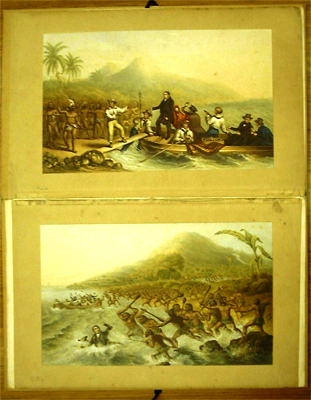Feature September 2012
Starr Collectors
The appreciation and collection of Baxter prints was revitalised after Dr Lawson Tait exhibited his large collection in Birmingham in 1893 leading to the formation of the First Baxter Society in 1895.
Then the publication of several books on the subject of George Baxter and his prints by C T Courtney Lewis and others in the early 1900s led to a surge in interest, and the number of collectors caused prices of Baxter prints to reach unsustainable levels in the 1920s.
At this time there were records of some of the rare Baxter prints achieving higher prices in the saleroom than original paintings by Canaletto!
George Baxter's Crystal Palace, New York on Stamped Mount like that in the Starr Collection
 |
| George Baxter's Two Specimens of Printing in Oil Colours |
Since George Baxter began publishing his colour prints in the 1830s there have always been collectors of his work.
No two collectors are alike, some focus on collecting work related to a specific subject, like royalty, some want to acquire every print that George Baxter produced and others seek to enhance the record of Baxter’s life and works.
One couple who sought to collect every colour print that George Baxter produced were the Starrs.
Like a number of Baxter collectors in the first half of the 20th century, they were not based in the UK but were living in Toronto, Canada.
The first purchase for their collection was a needle box print bought by Mrs Starr from the antique shop of a Mr J M Simpson on Yonge Street, Toronto, shortly after the Starrs had married and moved to Toronto.
The enthusiasm of Mr Simpson had a great effect on the Starrs and the collecting of Baxter prints became a passion for them.
They often travelled to Britain and on several occasions were presented to the King; there are examples of invitations to meet Royalty and to attend Royal Garden Parties amongst their collection.
These visits to London provided opportunities to extend the collection and on one of their earlier trips they became acquainted with Courtney Lewis, a meeting which no doubt heightened their interest in George Baxter further.
By the mid 1940s the Starrs had amassed an extremely fine and almost complete collection that included many of the rarer prints.
The Starr Collection of Baxter Prints was presented to Victoria University, Toronto, in 1945 by Anne Callander MacKay Starr in memory of her husband, Frederic Newton Gisborne Starr, CB.E, M.B., M.D.C.M., FR.C.S.(CAN), F.R.G.S.
Mrs Starr opened the first exhibition of the collection on April 5th 1945 and in November 1953 she generously gifted the rarest of Baxter prints, Mr and Mrs Chubb, to the University.
The Starrs record that the Chubb prints were discovered in Ottawa in 1921 having been brought to Canada in the 1860s by Mrs Smith, a daughter of the English locksmith.
They state that Captain Percy F Godenrath sold the prints in London, on behalf of the owners, for $1500 the pair.
This is supported by the Baxter Times article of November 1923, which tells of how a young girl entered an exhibition in Ottawa with a parcel under her arm which, when opened, contained the two Chubbs!
This Collection is undoubtedly one of the finest and most complete collections of Baxter prints and is being well cared for by the Victoria University Library in Toronto.
The University also hold collections of Le Blond and other licensee prints and for anyone interested, the collections are well documented on the
Victoria University’s website.
Check out our
Collections page for more links to the information at the Victoria University Library.
Today, prints by George Baxter and his Licensees can be found for as little as a few Pounds, Dollars or Euros making it fairly affordable to start a collection now.
However, it is most unlikely that anyone collecting today could acquire a collection of the quality and completeness of the Starr Collection. Over time many collectors have left their collections to Museums and Universities around the world making them accessible to the public but also taking many of the best and rarest examples of Baxter prints out of circulation.